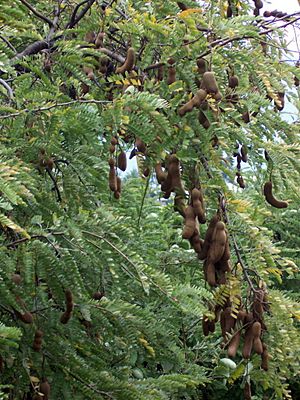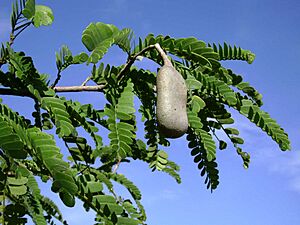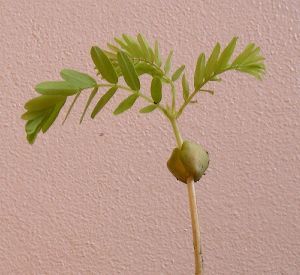Tamarind facts for kids
Quick facts for kids Tamarind |
|
|---|---|
 |
|
| Scientific classification | |
| Kingdom: | |
| Division: | |
| Class: | |
| Order: | |
| Family: | |
| Subfamily: | |
| Tribe: |
Detarieae
|
| Genus: |
Tamarindus
|
| Species: |
T. indica
|
| Binomial name | |
| Tamarindus indica |
|
The Tamarind (Tamarindus indica) is a tall, leafy tree that belongs to the Fabaceae family. It is known for its tasty, pod-like fruit. This amazing tree grows mostly in Africa, especially in a country called Sudan. It is also found in many other warm parts of the world.
Contents
What is a Tamarind Tree?
The tamarind tree is a tropical plant that can grow very large. It can reach heights of up to 25 meters (about 80 feet). It has a thick trunk and wide-spreading branches. The leaves are bright green and grow in feathery clusters.
Where Tamarind Trees Grow
Tamarind trees love warm, sunny places. They are native to Africa but have been grown in India for thousands of years. Today, you can find them in many tropical and subtropical regions. This includes places like Mexico, the Caribbean, and Southeast Asia. They can grow well in dry areas, too.
What Tamarind Fruit Looks Like
The fruit of the tamarind tree grows in long, curved pods. These pods look a bit like large, brown beans. Inside the pod, there is a sticky, brownish pulp. This pulp surrounds several hard, shiny seeds. The pulp is the part that people eat and use.
Uses of Tamarind
Tamarind is a very useful plant. People use its fruit, leaves, and even its wood. The most common use is for its fruit pulp.
Tamarind in Food
The pulp of the tamarind fruit has a unique sweet and sour taste. It is used in many different cuisines around the world.
- In Asia, it's a key ingredient in sauces, curries, and drinks.
- In Mexico, it's popular in candies, snacks, and refreshing drinks.
- It's also used to make chutneys and jams.
- Some people even use it to polish metals because of its acidic nature!
Other Uses of the Tamarind Tree
Beyond food, the tamarind tree has other important uses.
- The wood of the tamarind tree is strong and durable. It is used for making furniture and tools.
- In some traditional medicines, parts of the tamarind tree are used. They are believed to help with digestion and other health issues.
- The leaves and flowers are also sometimes used in cooking or for decoration.
Life Cycle of a Tamarind Tree
Tamarind trees can live for a very long time, sometimes over 200 years! They start from a seed and grow into a large, fruit-bearing tree.
How Tamarind Trees Reproduce
Tamarind trees produce small, yellowish-red flowers. These flowers grow in clusters. After the flowers are pollinated, they develop into the long, brown pods that hold the fruit. The seeds inside these pods can then be planted to grow new tamarind trees. A young tamarind tree is called a seedling.
Images for kids
-
Tamarind tree on the site of the founding of Santa Clara, Cuba
See also
 In Spanish: Tamarindo para niños
In Spanish: Tamarindo para niños







